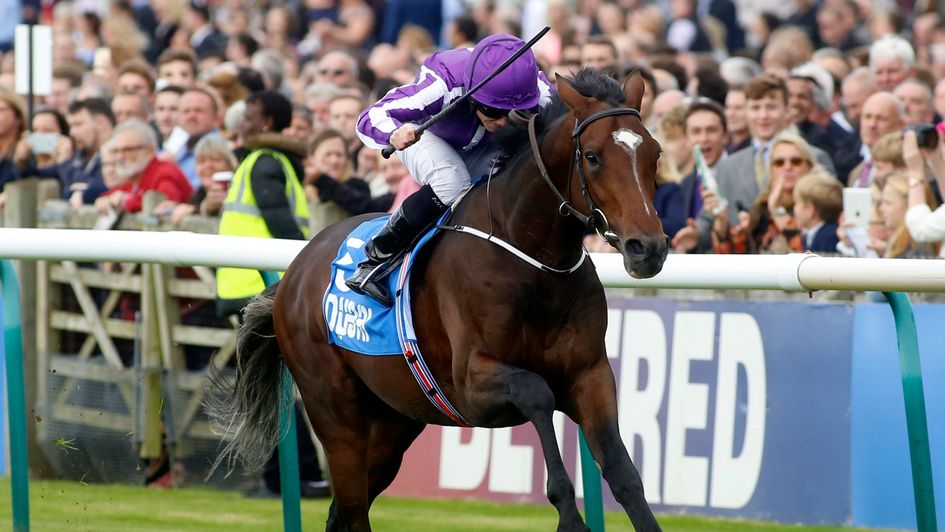Will Duff Gordon, CEO of Total Performance Data, looks at the stride data of St Leger favourite Kew Gardens in the first of a fortnightly series.
Introduction
Total Performance Data has a clear goal – to have a timing sensor on every horse in every race around the world. Ambitious? Of course it is, but we are at least on the way to this with 12 racecourses set up in the UK, US and Canada and we do over 1,000 racedays a year, too. This number is rising fast. We’ve already timed and published data on 7,000 races and tracked over 50,000 runners.
Timing racehorses is no new feature but what has changed is that GPS is now able to do the job that far more complex and expensive systems used to do. We were the first to move to this new technology and take things up where Turf Trax and Trakus left off and the British Horseracing Authority helped pave the way by making speed sensors mandatory.
Sectionals versus Tracking
Sectional timing, as the name suggests, means recording running times between two points. This can and is done by laser beams and stopwatches. In contrast, GPS and local positioning systems (as used by older tracking companies) are constantly tracking the horse from the moment they are saddled and emitting very fast live data.
This is handy when a trainer drives off with the sensor! It also means other things are recorded like distance run, strides per second and, one day, live heart rates in races. This is all done with a single small sensor. It also opens doors to using the data for other in-race products like in-running betting.
Kew Gardens looks ideal type for the Leger
Coolmore’s Kew Gardens is favourite for the William Hill St Leger. Some will find him tempting to oppose at his price (best of 13/8) given that he scoped dirty ahead of the King George, but there is some TPD data to assess amidst all this conjecture as a result of his second place in the Winter Derby Trial at Lingfield.
Horse: Kew Gardens
- May 12 2018
- Racecourse: Lingfield Turf - Good to Firm (Watered)
- Distance 1m 3f 133 yards (class 1)
- Peak average strides per second: 2.27
- Peak average feet per stride: 25.34 feet
Compared with…
Horse: Bajan Gold
- June 23 2018
- Racecourse: Lingfield Turf – Good to Firm
- Distance 1m 2f (class 5)
- Peak average strides per second: 2.38
- Peak average feet per stride: 24.00 feet
Is he crying out for 1m 6f?
TPD capture strides per second and this compliments the timing data. Within about two weeks of releasing this cadence data, one savvy owner (Chris Dixon) used it to target a race at Chelmsford for Locommotion which he duly won.
Sprinters, stayers and elite horses are recognisable through stride patterns so this data is especially useful for assessing the right trip for horses to race over. According to the excellent freelance writer Simon Rowlands, who specialises in sectional times, horses running on the Turf over 14 furlongs (the St Leger distance) do a maximum average of 2.30 strides per second and a minimum average of 2.09. Their max average stride length is 25.1 feet.
In other words, Kew Gardens looks well suited to the trip based on his cadence over 1m3f at Lingfield back in May. And while we already know his effectiveness over 1m6f thanks to his Queen’s Vase win at Royal Ascot, this enforces the point that he’s expected to be racing over his optimum distance in Saturday’s Classic on Town Moor.
More about why we set up TPD…
I was once lucky enough (thanks to Hugo Palmer’s astute buying skills) to own a decent horse in Short Squeeze who took me racing to places where he carried speed sensors.
When I assessed the York and Meydan data it became clear what was really meant by the expression ‘the horse needs cover’ and ‘they need to go a good gallop’. If the leaders went fast, Short Squeeze would have a better chance of winning the race. If they crawled early on he would more likely finish last as he did in the Hunt Cup one year.
This factual insight was my eureka moment when the heat-of-the-moment jockey feedback was all one could rely on when digesting another winless race. Then after four years serving on the Racehorse Owners board (ROA) it was time to implement some innovation rather than just talking about the need for some. Since time is money in this business, it’s time for more times.
